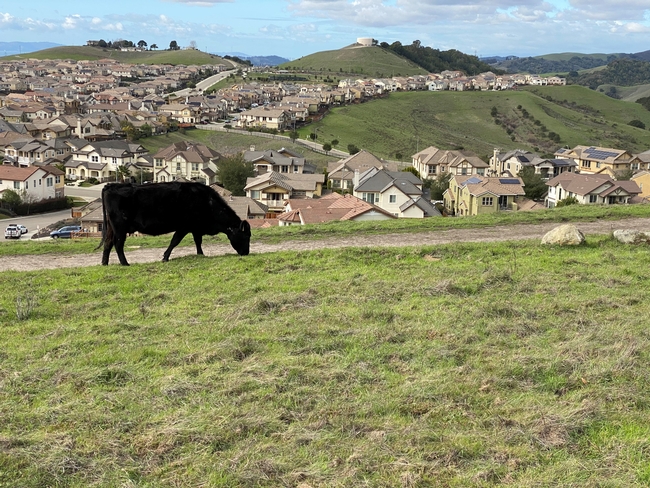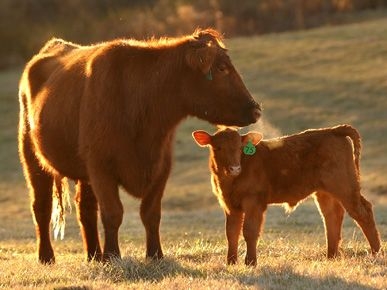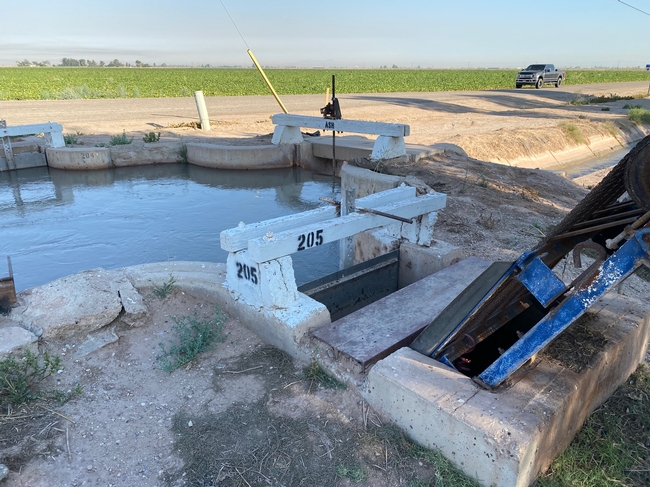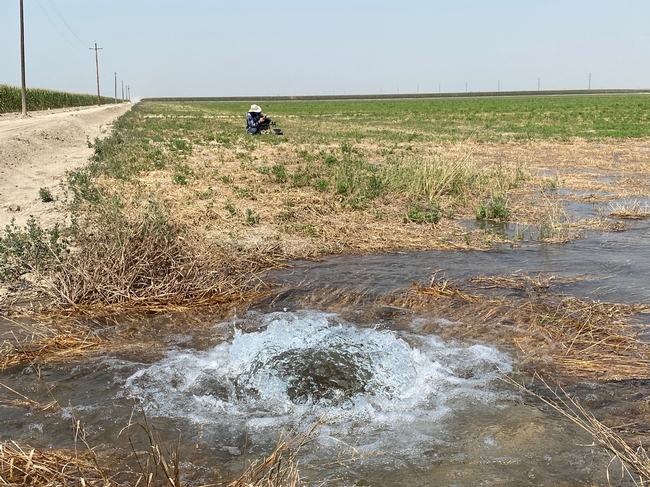
Posts Tagged: Larry Forero
New UC ANR publication educates public on cycles of cattle production, grazing and economics
The pandemic has brought more people into nearby parks and public lands for hiking, biking and other recreational activities. In areas like the East Bay Regional Parks – a San Francisco Bay Area park system totaling more than 120,000 acres where about 65% of the land is grazed by livestock – visitors might see goats, sheep and, most likely, cattle.
Those encounters with animals (or their manure) represent a prime opportunity for members of the public to learn about agriculture and the ecological benefits of rangelands, according to Larry Forero, a UC Cooperative Extension livestock and natural resources advisor.

As livestock grazing (mostly by beef cattle) constitutes a significant portion of land use across the state, Forero – along with fellow UCCE advisors Sheila Barry and Stephanie Larson – recently authored a UC Agriculture and Natural Resources publication summarizing the mechanics of cattle production.
“Beef Cattle on California Annual Grasslands: Production Cycle and Economics,” published in October and available as a free download on the UC ANR Catalog, describes the seasonal phases of cattle production and the factors that impact ranchers' financial calculations and management decisions.
“This concise publication walks through annual stock flows and calendar of operations and gives tables for estimating costs, return over cash, and gross income under various scenarios,” said Forero.

“Even if only a relatively small percentage of park goers are interested, you still touch a lot of people with a document like this,” Forero explained.
He said he hopes park signage and QR codes will direct visitors to the publication for more information about the cattle and their seasonal movements.
“People often wonder where the cattle go when they leave the park and when they will return,” co-author Sheila Barry said. “The cattle may go to grass or feed yards in other places in California or even out of state.”
But, as this new UC ANR publication explains, the cattle production cycle turns over anew.
“There will be more cattle next fall, I promise,” Barry said.
Water measurement and reporting course offered by UCCE May 20
Learning from the University of California Cooperative Extension how to correctly install and maintain a water volume measurement system on his ranch has saved Modoc County rancher Glenn Nader a significant amount of money.
Nader, a retired UC Cooperative Extension advisor himself, and his wife have owned and operated a 2,880-acre ranch in Modoc County since 1999.
“We divert irrigation water out of the creeks on the ranch for irrigation of the cattle pastures and hay fields,” Nader said. “The State of California required that we hire a certified engineer to set up and maintain water measurement devices at three locations on the ranch. Because of our remote location, the cost of an engineer would have been over $4,000 for set up alone.”
“After the class, I was confident that we could meet the state standards and that I could implement a water measurement system on our ranch.”
After Senate Bill 88 became law in 2015, California water-rights holders who have diverted or intend to divert more than 10 acre-feet per year or who are authorized to divert that amount of water have been required to measure and report the water they divert from surface streams. For people who wish to take the water measurements themselves, state law allows UC Cooperative Extension training to receive certification.
A virtual training is scheduled for May 20, 2021, beginning at 1 p.m. and concluding at 4 p.m. Registration is $25 and includes downloadable course materials. Register at https://ucanr.edu/survey/survey.cfm?surveynumber=33616.
At the workshop, participants can expect to:
- clarify reporting requirements for ranches
- understand what meters are appropriate for different situations
- learn how to determine measurement equipment accuracy
- develop an understanding of measurement weirs
- learn how to calculate and report volume from flow data
“There will be a limited number of water measurement trainings offered in 2021,” said Larry Forero, instructor and UC Cooperative Extension livestock and natural resources advisor. “If you need this training, register soon.”
If you have any questions about this training, please contact Forero at lcforero@ucanr.edu or Sara Jaimes at sbjaimes@ucanr.edu or by calling the UCCE office in Shasta County at (530) 224-4900. For additional information about AB 589, which called for this training, please visit https://ucanr.edu/sites/AB589.
Background:
Senate Bill 88 requires that all water right holders who have previously diverted or intend to divert more than 10 acre-feet per year (riparian and pre-1914 claims), or who are authorized to divert more than 10 acre-feet per year under a permit, license, or registration, to measure and report the water they divert.
Detailed information on the regulatory requirements for measurement and reporting is available on the State Water Resources Control Board Reporting and Measurement Regulation webpage. The legislation as written requires for diversion (or storage) greater than or equal to 100-acre feet annually that installation and certification of measurement methods be approved by an engineer/contractor/professional.
The California Cattlemen's Association worked with Assemblyman Frank Bigelow to introduce a bill that would allow a self-certification option. Assembly Bill 589 became law on Jan. 1, 2018. This bill, until Jan. 1, 2023, allows any diverter, as defined, “who has completed this instructional course on measurement devices and methods administered by the University of California Cooperative Extension,” including passage of a proficiency test, to be considered a qualified individual when installing and maintaining devices or implementing methods of measurement. The bill required UC Cooperative Extension and the board to jointly develop the curriculum for the course and the proficiency test.
UC helps cattle ranchers estimate costs and returns of beef production

To help ranchers make business decisions, new cost studies for beef cattle production have been released by UC ANR Agricultural Issues Center and UC Cooperative Extension.
Sample costs and returns for beef cattle production in the northern Sacramento Valley are presented in these studies. The studies are titled “Sample Costs for Beef Cattle, Cow–Calf Production,” “Sample Costs for Beef Cattle, Yearling/Stocker Production” and “Sample Costs for Beef Cattle, Finished on Grass.”
"These studies are useful to new and experienced ranchers, lenders and other agribusiness companies, as well as government officials, researcher and students who want to know basics of ranch practices and the costs and returns that can be expected for a well-managed operation,” said Daniel Sumner, director of the UC Agricultural Issues Center. “The studies show ranges of net returns under alternative price scenarios to help indicate sensitivity of returns to cattle market conditions."
The analyses are based on a hypothetical well-managed ranching operation using practices common to the northern Sacramento Valley. The three studies are based on a herd of 300 cows and bred heifers, 60 yearling heifers and 15 bulls. An 11 percent cull rate is applied to the herd. An 89 percent calf crop with three percent mortality before weaning is assumed.
All rangeland and pasture is rented per animal unit month. Ranging analysis tables show net revenue over a range of prices. The costs, materials and operations shown in this study will not apply to all ranches. Ranchers, UC Cooperative Extension farm advisors, and other agricultural associates provided input and reviewed the methods and findings of the study.
Free copies of these studies and other sample cost of production studies for additional commodities are also available. To download the cost studies, visit the UC Davis Department of Agricultural and Resource Economics website at https://coststudies.ucdavis.edu.
The cost studies program is funded by the UC Agricultural Issues Center and UC Cooperative Extension, both of which are part of the UC Division of Agriculture and Natural Resources, and the UC Davis Department of Agricultural and Resource Economics.
For more information or an explanation of the calculations used in the studies, contact Donald Stewart at the Agricultural Issues Center at (530) 752-4651 or destewart@ucdavis.edu; Larry Forero, UC Cooperative Extension farm advisor for Shasta and Trinity counties, at lcforero@ucanr.edu, or Jeff Stackhouse, UC Cooperative Extension farm advisor for Humboldt and Del Norte counties, at jwstackhouse@ucanr.edu.
NOTE: Corrections were made on July 19, 2017, to “2017 Beef Cattle Yearling/Stocker Production in the Sacramento Valley” and “2017 Beef Cattle Finished on Grass in the Sacramento Valley” to show interest calculated for 6 months as stated in the narratives of both studies, instead of 12 months.
UCCE's Larry Forero is helping ranchers cope with drought

The story said Forero is working with a rancher in eastern Shasta County to measure the efficiency of well water on irrigated pasture. He plans to share results with other ranchers at "irrigation school" in January. (Date and location TBA at http://ceshasta.ucanr.edu.)
“If they're over-irrigating in September or October, could we do something different with that water?” Forero said. “What we're hoping with this irrigation school is to get this real-time data out there and share it with participants so they can look at what alternatives they might develop with irrigation scheduling.”
Forero is well-positioned to help with new regulations that will likely come down now that Gov. Brown has signed legislation that will give the state water board broad control over groundwater in California. Forero has experience helping farmers comply with new regulations.
In 2012, when local farmers with surface water rights had to begin submitting precise monthly water-use records, Forero and his colleague UCCE advisor Allan Fulton wrote a paper that explained how to measure surface water diversion.
"What we really tried to do," Forero said, "is make it so it wasn't so overwhelming that people said, 'I don't have time to do this.' From a Cooperative Extension perspective, we don't buy, sell or regulate. We try to provide ideas for folks, and what they do with them is up to them.”
It's raining in California, but drought concerns haven't been quenched

A story in the Los Angeles Times this week opened with the concerns of cattle ranchers. Without winter rain rangeland grass doesn't grow. Ranchers must decide whether to buy expensive feed or cull their herds to weather the drought.
"Their struggle is a bellwether for California's $45 billion agriculture sector," wrote reporter David Pierson. The repercussions will be felt beyond the state's borders. "The Golden State produces nearly half of all U.S.-grown fruits, nuts and vegetables and is the nation's leading dairy and wine producer."
Pierson quoted Doug Parker, director of the UC California Institute for Water Resources, in his article.
"The agriculture industry is definitely hit the hardest by drought," Parker said. "In California, agriculture uses 80 percent of water in the state. It's a major input for their business and hits their finances and employment directly."
The San Luis Obispo Tribune reported on drought hardships for SLO County fruit and vegetable farmers. Growers are facing increasing irrigation costs and taking steps to reduce salt buildup in the soil.
"The drought forces growers to prioritize crop cycles,” said Mary Bianchi, UC Cooperative Extension adviser. “What do you plant, and what do you leave fallow?”
In Stanislaus County, ranchers are expressing concerns about a trend among farmers toward planting almonds, reported the The Modesto Bee. Ranchers are worried the spread of almonds, walnuts an other high-value crops could strain their limited groundwater, drive up land prices and intrude on their way of life.
“It's not hard to understand why (farmers are planting more almonds),” said Roger Duncan, UCCE advisor. “It's very profitable.”
It was Duncan who provided the rough figures on almond profitability during the first day of the ninth annual summit of the California rangeland Conservation Coalition recently, wrote Bee reporter John Holland. Duncan said the net is even better for walnuts, which are not as extensive but still have had major growth in acreage. He also said the nut boom could be limited by a shortage of water and land.
The Drovers Cattle Network reported that cattle ranchers are seeking strategies for surviving the drought.
According to the article, rancher Billy McDonald's wife, Aileen, said she learned from UC Cooperative Extension farm advisor Glenn Nader that "you need to set a date, like if it doesn't rain by a certain date, to start culling. That's really important."
Also as part of the story, Roger Ingram, UCCE advisor in Placer and Nevada counties, advised ranchers to develop a drought plan.
Ingram warned against overgrazing and emphasized the importance of leaving enough residual dry matter in the ground to enhance seed germination and minimize soil erosion. With more bare ground, water would run off instead of soaking in, he said, and there would be less organic matter to feed soil microbes, resulting in fields being overrun by undesirable plants such as medusahead and yellow starthistle.
"Your grazing strategy should be take half, leave half," he said.
For those who are on irrigated pasture with limited water supply, UCCE advisor Larry Forero said fields are the driest in the summer but can get by with less water in the fall, so irrigate as close to evapotranspiration as possible and then stop irrigating. He also advised leaving four to five inches of stubble to facilitate pasture growth in the fall, should it rain or irrigation water become available.



